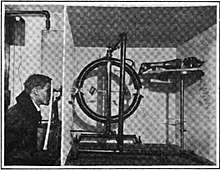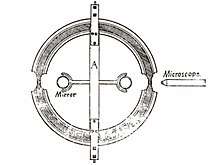Compton generator
A Compton generator[1][2] or Compton tube[3] is an apparatus for experiment to demonstrate the Earth's rotation, similar to the Foucault pendulum and to gyroscope devices.[4]

Explanation of apparatus

A Compton generator is a circular hollow glass ring tube shaped like a doughnut, the inside of which is filled with water.[1] If the ring lies flat on the table, the water in the ring is stationary, and it is then turned over by rotating itself 180 degree around a diameter, such that it again lies flat on the table surface, which is horizontal. The result of the experiment is that the water moves with a certain constant drift velocity around the tube after the doughnut has been rotated. If there were no friction with the walls, the water would continue to circulate indefinitely.[1]
The ring used in the initial experiment was made of one inch brass tubing bent into a circle eighteen inches in diameter, where the windows were placed the tube was constricted to a diameter of about three eights of an inch.[5]
Compton used small droplets of coal oil mixed in the water to measure the drift velocity under a microscope.[6]
Analysis
Assume the diameter of the glass tube is much smaller than the diameter of the ring, and is the radius of the ring, is the Earth rotation rate and is the latitude.
Initially the ring is horizontal and the water is stationary. Second the ring is then quickly rotated by 180° around its East-West diameter and stopped, such that it again lies flat on the table surface, which is horizontal. At this time, the velocity of the water in the tube is given by
Note that a rotation from the vertical to the vertical position produces the velocity of the water in the tube is given by
Experimental verification
Compton used this measured drift velocity to determine his latitude to within 3% accuracy.[6]
References
- Analytical Mechanics, p. 280.
- Classical Mechanics, p. 365.
- Blackie's Dictionary of Physics, p. 72.
- A laboratory method of demonstrating the Earth's rotation 1913, p. 803.
- A determination of latitude, Azimuth, and the length of the day independent of astronomical observations 1915, p. 110&111.
- Analytical Mechanics, p. 281.
Bibliography
Journal
- Compton, Arthur Holly (1913). "A laboratory method of demonstrating the Earth's rotation". Science. 37 (960): 803–806. Bibcode:1913Sci....37..803C. doi:10.1126/science.37.960.803. PMID 17838837.
- Compton, Arthur Holly (1915). "A determination of latitude, Azimuth, and the length of the day independent of astronomical observations". Physical Review. 5 (2): 109–117. Bibcode:1915PhRv....5..109C. doi:10.1103/PhysRev.5.109.
- Compton, Arthur Holly (1915). "Watching the Earth revolve". Scientific American Supplement. 79 (2047supp): 196–197. doi:10.1038/scientificamerican03271915-196supp.
Books
- Hand, Louis N. (1999). Analytical Mechanics. Cambridge University Press. ISBN 978-0521575720.
- Taylor, John R. (2005). Classical Mechanics. S.Chand & Company Ltd. ISBN 978-1891389221.
- Blackie's Dictionary of Physics. S.Chand & Company Ltd. 2000. ISBN 978-8121942379.
| Wikimedia Commons has media related to Compton generator. |